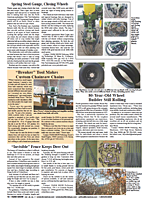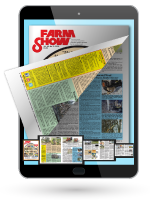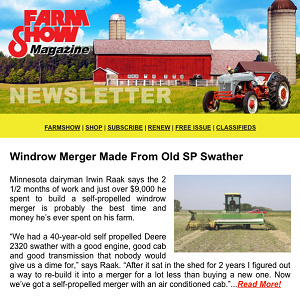Toolbar Laser Real-Time Soil Analysis
 ✖  |
TerraBlaster is using technology developed for the Mars rovers to provide real-time soil analysis. Prototypes under development will be capable of capturing 15 different soil properties, including 13 different macro and micronutrients, plus moisture, pH and organic matter.
“We’re in the very early stages of prototype development and testing, but we know we can provide very accurate measurements,” says Jorge Heraud, TerraBlaster. “We’re building five for the next generation. With those, we’ll be able to gather data on tens of thousands of acres.”
Mounted to toolbars, tillage equipment or other field equipment, the TerraBlaster module will deliver continuous, detailed soil data as it travels through the field. The data can be used to develop detailed field maps for all types of adjustable-rate, precision ag uses, from fertilizer application to planting and sidedressing. Mounted to the planter or applicator, it’ll provide real-time data for immediate use. The implications for fertilizer application alone are huge.
“Farmers spend a quarter of a trillion dollars a year on fertilizer application worldwide,” says Heraud. “Depending on the crop, it’s usually the number one expenditure. We believe we can save farmers between 10 and 20% on applications while also increasing their yields.”
TerraBlaster has only been in business for seven months, but the technology dates back decades. It combines lasers and spectroscopy in a technique known as laser-induced breakdown spectroscopy, initially developed by a NASA-funded company to analyze Martian soil remotely. The technology proved successful during its test on Mars and continues to perform reliably. The Curiosity rover, which landed in 2012, is still active today.
The laser creates a plasma of excited atoms and ions, which emit a light spectrum that the sensor can analyze. The multi-channel spectrometer measures thousands of data points. It’ll measure total nutrient levels, as well as plant soluble levels and the difference between them, notes Heraud.
“We believe this data is the missing piece in precision agriculture,” he says. “University researchers we have spoken with say real-time soil analysis is a game changer.”
Heraud has a deep understanding of the potential and the challenges that precision agriculture has faced. He spent a decade with Trimble before co-founding Blue River Technologies, the source for John Deere’s See & Spray technology, acquired in 2017. Since leaving Deere, he has advised several ag tech startups before focusing on and joining TerraBlaster.
“We’re taking this technology and making it less costly,” says Heraud. “Advances have been made in mobility, optics, spectronics and lasers since it was first developed by NASA. It’s all been getting less and less expensive. We’re ensuring it’s accurate, rugged and dependable.”
The initial prototypes will be self-contained systems. Eventually, Heraud expects TerraBlaster to be integrated with existing in-cab controllers and monitors.
“Our first step is to develop a production version,” says Heraud. “Once we have it, we’ll sign up dealers who can do retrofit installations on existing equipment.”
He’s confident that eventually farmers will be able to order the technology on new equipment. With it, he believes yield-limiting factors will be identified as never before.
“Potential yield increases have always been limited by some factor,” says Heraud. “With TerraBlaster, we’ll be able to know what in the soils is limiting yields. No longer will we have to rely on soil samples that are several years old or collected on grid sampling of every few acres. We’ll have instant analysis of every inch TerraBlaster travels through the field.”
Contact: FARM SHOW Followup, TerraBlaster (www.terrablaster.com).

Click here to download page story appeared in.
Click here to read entire issue
Toolbar Laser Real-Time Soil Analysis
TerraBlaster is using technology developed for the Mars rovers to provide real-time soil analysis. Prototypes under development will be capable of capturing 15 different soil properties, including 13 different macro and micronutrients, plus moisture, pH and organic matter.
“We’re in the very early stages of prototype development and testing, but we know we can provide very accurate measurements,” says Jorge Heraud, TerraBlaster. “We’re building five for the next generation. With those, we’ll be able to gather data on tens of thousands of acres.”
Mounted to toolbars, tillage equipment or other field equipment, the TerraBlaster module will deliver continuous, detailed soil data as it travels through the field. The data can be used to develop detailed field maps for all types of adjustable-rate, precision ag uses, from fertilizer application to planting and sidedressing. Mounted to the planter or applicator, it’ll provide real-time data for immediate use. The implications for fertilizer application alone are huge.
“Farmers spend a quarter of a trillion dollars a year on fertilizer application worldwide,” says Heraud. “Depending on the crop, it’s usually the number one expenditure. We believe we can save farmers between 10 and 20% on applications while also increasing their yields.”
TerraBlaster has only been in business for seven months, but the technology dates back decades. It combines lasers and spectroscopy in a technique known as laser-induced breakdown spectroscopy, initially developed by a NASA-funded company to analyze Martian soil remotely. The technology proved successful during its test on Mars and continues to perform reliably. The Curiosity rover, which landed in 2012, is still active today.
The laser creates a plasma of excited atoms and ions, which emit a light spectrum that the sensor can analyze. The multi-channel spectrometer measures thousands of data points. It’ll measure total nutrient levels, as well as plant soluble levels and the difference between them, notes Heraud.
“We believe this data is the missing piece in precision agriculture,” he says. “University researchers we have spoken with say real-time soil analysis is a game changer.”
Heraud has a deep understanding of the potential and the challenges that precision agriculture has faced. He spent a decade with Trimble before co-founding Blue River Technologies, the source for John Deere’s See & Spray technology, acquired in 2017. Since leaving Deere, he has advised several ag tech startups before focusing on and joining TerraBlaster.
“We’re taking this technology and making it less costly,” says Heraud. “Advances have been made in mobility, optics, spectronics and lasers since it was first developed by NASA. It’s all been getting less and less expensive. We’re ensuring it’s accurate, rugged and dependable.”
The initial prototypes will be self-contained systems. Eventually, Heraud expects TerraBlaster to be integrated with existing in-cab controllers and monitors.
“Our first step is to develop a production version,” says Heraud. “Once we have it, we’ll sign up dealers who can do retrofit installations on existing equipment.”
He’s confident that eventually farmers will be able to order the technology on new equipment. With it, he believes yield-limiting factors will be identified as never before.
“Potential yield increases have always been limited by some factor,” says Heraud. “With TerraBlaster, we’ll be able to know what in the soils is limiting yields. No longer will we have to rely on soil samples that are several years old or collected on grid sampling of every few acres. We’ll have instant analysis of every inch TerraBlaster travels through the field.”
Contact: FARM SHOW Followup, TerraBlaster (www.terrablaster.com).
To read the rest of this story, download this issue below or click
here to register with your account number.







